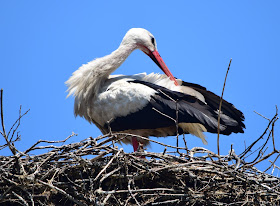I caught this stork preening itself on its nest in the village of Pieczyska. The nest, close to the church, was low enough to get a good view standing on the pavement. I saw four other large stork's nests this weekend, but they only afforded a glimpse of the stork's head and neck.
I observed this stork for several minutes; it looks like an elderly individual by the chips on its beak and a generally scruffy mien. It looked like it was itching all over, scratching its head and neck
This did not look like a happy or comfortable stork.
As usual, Wikipedia proves invaluable. I discover at home that the European white stork "has few natural predators, but may harbour several types of parasite; the plumage is home to chewing lice and feather mites, while the large nests maintain a diverse range of mesostigmatic mites."
In the Middle Ages, people thought that storks were conceited as they seemed to be forever preening. Yet this is now known to be a reaction to parasitical infestation.
All the stork's nests I saw this weekend were on man-made platforms, built in villages to keep the storks from building their own nests on electricity pylons or other bits of critical infrastructure - a stork's nest can weigh up to two tonnes.
Poland has the world's largest stork population; around a quarter of all white European storks live here.
UPDATE: MONDAY 6 JUNE 2016 Returning home from W-wa Dawidy station via the ponds on ul. Dumki, I caught sight of a black stork. First time I'd ever seen one. Not related to the heron - it flies with an outstretched neck, nor to the crane. Black, with some white under the wings.
This time three years ago:
Preserving meadowland - UK and Poland
This time four years ago:
This time five years ago:
Cara al Sol - a short story
This time six years ago:
Pumping out the floodwater
This time seven years ago:
To Góra Kalwaria and beyond
This time eight years ago:
Developments in Warsaw's exurbs



No comments:
Post a Comment